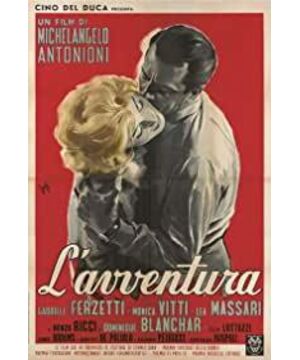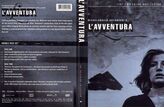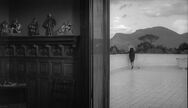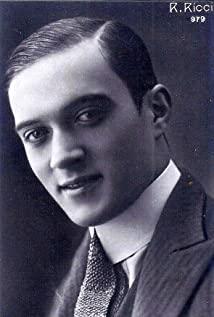"Adventures" marked the gradual maturation of Italian modernist cinema and was a great starting point for Antonioni's cinematic aesthetics. No matter in terms of actor performance, plot design or performance style, "Adventures" is the foundational work of Antonioni in the true sense.
■ "Adventure" is the beginning of Antonioni's "Love Trilogy" ("Adventure", "Night", "Eclipse"), the story revolves around a journey. Claudia accompanies Anna and Sandro, who are talking about marriage, but they are already separated, and their displeasure becomes more and more acute. After a quarrel with Sandro on the island, Ana suddenly and inexplicably disappears. When her news is elusive, her close friend Claudia and Sandro have secret feelings for a few days, and Claudia has been unable to get rid of Anna's shadow under the guilt of her conscience. Claudia is heartbroken when she decides to accept Sandro's pursuit, but unexpectedly discovers that Sandro is making out with another woman. Finally, facing the vast sea, Sandro was sobbing, and Claudia, who was heartbroken, stood silently beside him.
■Compared with Antonioni's other films, "Adventures" has a slightly stronger narrative, but it is still very different from tradition. The most prominent feature is that there is a lot of blank space in the plot, and the dramatic conflict is highly simplified or even partially abandoned , replaced by the psychological changes of the characters. There is a very special character handling: after the film begins, Anna is undoubtedly the protagonist. The dialogue between the father and daughter at the beginning of the film serves as the trigger for the plot, reflecting Anna's psychological state: on the one hand, she is dissatisfied with Sandro, who has not been with her for a long time, but she can't wait to go to sea with the latter. The conflicting psychology becomes the external action of the characters On the other hand, the intervention and opposition of the father formed a strengthening of the ambivalence, so Anna became more worried about the uncertain relationship. This is the psychological basis for her unhappy breakup with her boyfriend.
The sudden disappearance of Anna as the "protagonist" thereafter created a huge impact on the senses, because the character did not disappear temporarily, but simply never appeared again. Anna's fate was completely ignored. From then on, she was just a symbolic name in other people's mouths. The rest of the plot was triggered by the search for Anna, but her whereabouts have never been explained, so it is a huge "stay". White". So the camera and the plot turn to focus on Claudia, making her the real protagonist. This kind of blank space is necessary. After that, Claudia's psychology will set off Anna's "existence", and the switching of the mental state subject can be successfully completed.
■For similar blank space, it often appears together with the seemingly unnecessary actions of the characters in the shot, and is often used to express subtle changes in inner activity. For example, when Ana and Sandro meet, the scene begins to shift in different spaces, and this segment lasts for nearly four minutes: at one point the camera focuses on the room, where Anna reluctantly kisses her boyfriend; at the next moment, it shifts to Claudia, who was waiting outside, first came to the gallery, and then returned to the apartment door to wait. Because she realized that the two were making out, she had to keep walking, and finally closed the outer door of the apartment. The ambivalence is emphasized when the camera is fixed on Anna's face, while Claudia is "bored" in the camera to reflect the difficulty of the waiting time.
Towards the end of the film, Claudia is waiting in the room for Sandro, which is a more typical "Antonionian boredom" scene, with a series of actions showing anxiety: tossing in bed, watching the time, roaming the room, Grimace in front of the mirror; and when she stared at the watch, chanted counting, wrote doodles in magazines, and walked into the bleak sea breeze to gaze at the endless sea water, she clearly expressed the mixed psychology of anxiety and unease while waiting for her lover; Then she ran down the stairs, and it was this psychological drive that manifested in her actions. At this time, the camera is fixed at the far end, and Claudia runs from the other end of the corridor to approach the camera. This shooting method prolongs the feeling of time and fully releases the anxiety of the characters.
■In all of these shots, the actions and whereabouts of the characters are superficially meaningless, implying a special kind of "blank" -- fully paving the way for the psychological state, doing everything possible to weaken the plot and dialogue, and at the same time Amplify the relationship between the characters and the environment in a quiet atmosphere to enrich the language that expresses the characters' psychology. However, these shots can still bring a sense of jump, such as an anxious Claudia looking around for Sandro, inadvertently finding him lying on top of the flirtatious woman. Before, there was only a few eye contact between Sandro and this woman, and it was unknown how they came together, so the plot was also very "accidental". This blank or default is also to highlight Claudia, who is the subject of psychological activities, and reflects the characteristics of "replacing narrative with psychology".
There are not many empty shots in the film. There is an example in the process of people looking for Anna on the island: the sky turns dark and the rainstorm is coming. The camera uses a large panorama to show the boundless ocean, the intricate rocks and the lapping waves, and highlight the accompanying natural sound. Although the characters are missing at this moment, the scenery and sounds are a kind of replacement for the characters' hesitation and hesitation: the feelings of Claudia and Sandro are secretly born at this time.
"Adventures" also has a great significance for Antonioni: he has finally found the most suitable woman for his film style - Monica Vitti who plays Claudia, her characteristic lazy and casual temperament and a little bit of confusion And the stern eyes, which are very consistent with the secret temperament of Antonioni's films. Many inner contradictions shown in "Adventures" depend on Vitti's performance, such as Claudia dancing in front of her lover while dressing to music, conveying the inner joy of a woman who is intoxicated with love. However, as soon as the camera turned, her dancing posture and smile were immediately stopped. She knelt down in confusion and uneasiness and asked the other party to show her love. This was an external manifestation of guilt and lack of security, and it also highlighted the complexity and variability of emotions.
Antonioni's modern film aesthetics is based on the neo-realism of De Sica and others, but the way of expression tends to be introverted. Unlike Fellini's films, it does not penetrate into people's hearts with dreams, but relies on The outside world in front of the camera is cryptically communicated. For example, when Claudia and Sandro appear together in Adventures, the shots are mostly jumping and breaking, and the axes where the two are constantly intersecting and changing, causing a strong sense of unease in their relationship; another example is the symbol of an isolated island. Desolation and indifference. At this time, all the characters are deviated from the center of the camera. At the same time, there is very little dialogue, and scenery is used instead of psychology. There is also Claudia's repeated emotional torture and Sandro's repeated desire transfer. These not only strengthen the expressive power of the characters' psychology, but also hide the realistic location of the film - the only thing people can do is to keep looking for new adventures, so it is full of such a complex: everyone is in Looking for excitement, looking for short-lived passions, always chasing and always losing. This complex leads to emotional uncertainty and difficulty in establishing character relationships.
The same is true at the end of the film: the hesitant Claudia puts her hand on the head of the remorseful Sandro, and the actors' performances and dialogue are still suppressed. The panoramic lens shows the obscured sky, the vast distant mountains and the dilapidated ruins. It is a metaphor for the emotional relationship between the two people, and the gloomy tones reflect the unstable emotions and monotony of people in reality. Indifferent view of love. The ending is still open: Anna remains silent, whether Claudia and Sandro's relationship has been saved or not, and the rest of the psychology and narrative is left to our own imagination.
View more about L'Avventura reviews









